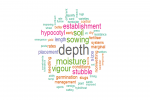Snapshot
Growers: Tom, Phil and Bindy Longmire
Farm location: Beaumont, Western Australia
Farm size: 5700ha
Average annual rainfall: 400 to 425mm
Soil types: circle valley loams, red and grey clays
Enterprise: 100 per cent cropping
Typical crop sequence: field peas/wheat/canola/wheat/canola/barley with opportunistic lentils
Careful research over many years prompted a family from Western Australia
to embrace autonomous crop protection
Tom Longmire says automating weed, slug, snail and mouse management on his family’s 5700-hectare grain farm has been a game changer.
For two years, the precision farming enthusiast and his parents, Phil and Bindy Longmire, have deployed an autonomous robot on Coorong Pastoral Company paddocks near Beaumont, 110 kilometres east-northeast of Esperance in Western Australia.
Tom told a GRDC and Society of Precision Agriculture Australia webinar that mapping how data flowed across his family’s business was a critical first step in achieving autonomy.
The family identified six core parts of its precision agriculture program that inform decision-making about fertiliser, varieties and crop rotation (Figure 1).
Figure 1: Data flow at Coorong Pastoral Company.

Source: Tom Longmire
“Data flows easily when files are named correctly,” Tom said. “Without this, moving between the different categories is always a battle. This is particularly important as we implement autonomy and an automated weather station network across the farm.”
The Longmire family started leasing a SwarmBot (autonomous robot) in February 2023. The robot tows an 18-metre Hayes boomspray with a 3000-litre tank. Weed-It cameras are fitted for summer spraying.
In May 2024, the family bought a one-tonne PJ Green bait spreader to autonomously apply slug, snail and mouse bait.
“Autonomous operations have been a big goal for us since 2016,” he said. “It wasn’t just a rush decision.”
Study tour
In 2016, Tom and his father, Phil, toured Australia’s east coast with a few other Esperance growers to explore autonomy.
They visited SwarmFarm in Queensland when the company’s robots were six-metre machines with 600-litre tanks. The group also visited Beefwood in New South Wales to inspect an autonomous Fendt tractor and other companies developing automated technologies.
When SwarmFarm developed an 18m machine with a 3000L tank, the Longmires decided it could provide a logistical benefit, enabling them to cover more hectares quickly.
“I’d rather have two 18m robots than one 36m machine because some gaps between obstacles, such as lakes, are closer than 36m. At 18m, it allows the robot to continue operating without needing to be folded,” Tom said.
“There is a benefit of getting right into the corners of paddocks with a smaller machine.”
The Longmire family’s robot is on a three-year lease. It works at 10 to 12ha per hour. However, it has a better work rate in open paddocks and is slower when working in paddocks with internal obstacles.
Tom said moisture conservation during summer was critical for the family’s dryland cropping program. “Previously, we couldn’t spray weeds efficiently during harvest because labour was fully utilised for the harvest operation. But the robot now follows four or five days behind the harvester,” he said.
“By the time we finish harvest, we are two-thirds through our first summer spray.”
When the robot is fitted with a spreader, one to 10 kilograms of slug, snail or mouse bait can be distributed 18m wide.
Canola pests
Tom said slaters and earwigs were problematic in emerging canola. However, the automated spreader allowed baits to be applied one day behind the seeder, which killed most pests before crops germinated.
The lease arrangement led the family to prioritise using the SwarmBot instead of their self-propelled boomspray. Tom said using the robot and camera sprayer to target fleabane and marshmallows was economical.
After 18 months, he estimated spraying 7661ha had saved $50,000 in depreciation costs on the family’s self-propelled boomspray.
Although the SwarmBot had not reduced labour, he said it had changed how work was done. For example, rather than spraying all night, Tom programs the robot for night spraying, goes to bed, receives a notification when it is finished and rises to fill, fuel and redeploy the machine.
Small weeds
He said the camera sprayer was accurate when working at 10km/hr. This means hitting canola volunteers when they are small. “We haven’t seen any misses.”
The other benefit is that there is no dust from wheel tracks, which can lower spray efficacy when a self-propelled sprayer works at higher speeds in dry summer conditions. The robot slows to 3km/h when approaching a corner.
Another benefit of the robot and camera sprayer combination was saving more than 250,000L of water over the summer.
In 2024, the family saved:
- $130,000 in chemicals from 4571ha sprayed; and
- 275,000L of water from no longer applying a 60L/ha blanket summer spray.
He said spraying two to five per cent of the farm was economical, and camera spraying performed well on difficult-to-control weeds.
Areas for improvement
According to Tom, SwarmFarm is developing and testing the robot’s capacity to complete a second interior headland lap to prevent triangle-shaped missed areas.
“The obstacle detection is very sensitive, but it is up to me to tidy up the corners of our paddocks and cut down overhanging tree branches so it doesn’t throw off the sensors. I trust the obstacle detection system; it hasn't hit anything across the area it has sprayed.”
Nonetheless, he said the setup was time-consuming, so having a good base layer of mapping data was critical.
Coverage maps
One problem Tom noted was he could not access any of his coverage maps, and none of the robot’s spray records could be transferred into the record-keeping platform Agworld or John Deere’s Operations Centre.
“Instead of technology suppliers offering individual platforms, we hope that SwarmBot data will one day integrate into Agworld and Operations Centre to track data and costs.”
Notwithstanding this, he said the company’s support for all other aspects had been exceptional.
Future developments
In future, Tom said he hoped to use the robot to apply trace elements according to soil type. Some sandy soils need copper, but heavy country requires none.
“If we can target copper to where it is needed, we will achieve efficiencies with a small robot while improving crop production,” he said.
“Also, adding auto-fill to the robot would prompt us to buy another one.”
He hoped sensors would become available to map soil moisture and areas colonised by snails.
This would enable on-the-go variable-rate fertiliser and bait application.
Tom said he could see a place where the SwarmBot could be used three to four times in small canola to target annual ryegrass, the family’s biggest weed threat.
However, he was focused on streamlining his automated farming system for now. One day, he said, there would be a role for green-on-green spraying when the technology was more reliable and purpose-built for an autonomous platform.
More information: Tom Longmire, tom@coopas.com.au
Resources: Paving the way for on-farm autonomy.

























































